Articles, Mucus-free Lifestyle, Mucusless Diet, Spira Speaks, Writings about Arnold Ehret, Writings by Arnold Ehret
Questions about the Annotated Mucusless Diet’s Vegetarian Recipes Lesson
Vegetarian Lessons? Prof. Spira shows how many recipes in the Vegetarian lesson were added by editor Fred Hirsch, and not Arnold Ehret.
*The following article about Ehret’s Vegetarian Lesson was written in response to questions in a Spanish-language Mucusless Diet forum and originally translated and released in Spanish.
Greetings Brothers and Sisters!
In light of recent concerns with the Spanish translation of my Annotated, Revised, and Edited edition of Arnold Ehret’s Mucusless Diet Healing System (get the new Spanish translation “>HERE), I would like to take the time and opportunity to thoroughly address them as well as I can.
I wish that I could engage with my Spanish speaking friends and discuss these issues directly on social media, but I do not speak or write in Spanish. Thus, I would like to thank Cindy Smithson for translating the following statement. First, allow me to share a brief background of the annotated project.
Why was an Annotated Version of the Mucusless Diet Needed?
I first learned about and started to practice Prof. Arnold Ehret’s Mucusless Diet Healing System over 15 years ago. When I started, I weighed over 300 pounds and suffered from numerous physical ailments, including chronic migraine headaches, sleep apnea, yearly bouts of bronchitis, fatigue, frequent ear infections, constant cold and flu-like symptoms, chronic constipation dry itchy skin, hemorrhoids, and bad body odor, to name a few.
Since my mother died at a young age, when I was only 12 years old, I thought that I was genetically predisposed to live a life of sickness and die young. However, after I read Arnold Ehret’s Mucusless Diet and Rational Fasting books, my life was transformed and I developed hope that I could heal myself! Within 6 months of applying Ehret’s methods I lost 100 pounds, overcame the ailments listed above, and got off of all of my pharmaceutical medicines, some of which I’d taken since I was seven years old. (For more information about my personal transformation, see this article: https://www.mucusfreelife.com/popular/profound-transition/
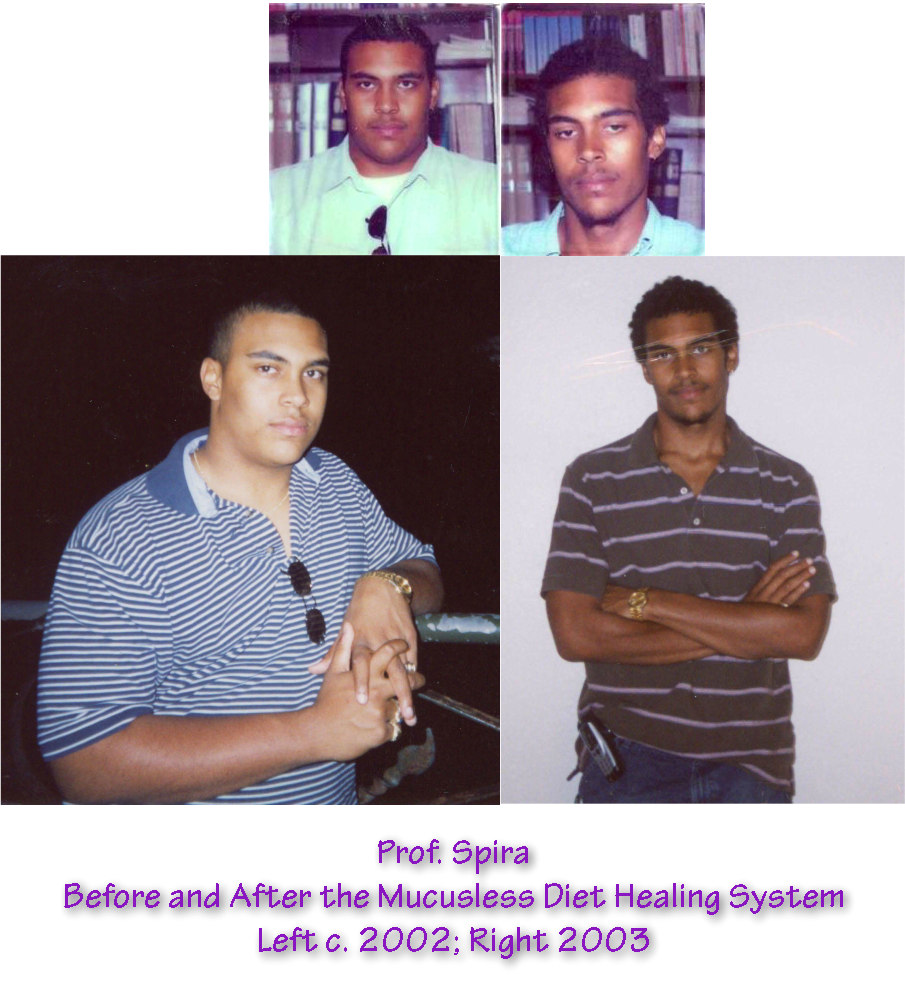
Figure 1. Top left photo taken at the beginning of my Mucusless Diet transition, and the top right is taken 1 year after the previous photo.
In the introduction to the Annotated Mucusless Diet, I explain:
“The inspiration for this newly edited, updated, and annotated version of Arnold Ehret’s Mucusless Diet Healing System emerged about 2 years after I had read the book. I could not stop reading the book over and over again, and found it to be a true work of genius! Yet, as I began to examine it more deeply, I noticed certain issues that might prevent first-time or contemporary readers from gaining full comprehension. Occasional archaic and hard-to-understand syntax, content contradictions, and the author’s collegial attempts to have dietetic dialogs with his peers, all of whom he was miles ahead of, cause many readers to misunderstand some aspects of his message.
Over the years, I have received many of the same questions from Mucusless Diet readers. The purpose of this book is to address some of the most common questions and make editorial updates for a twenty-first century audience. My goal is not to rewrite the Mucusless Diet, but to create a reference document that will facilitate comprehension and understanding for modern audiences. My notes and additions will appear in several ways, including endnotes, italicized and indented sections before or after lessons, and editorial notes inserted into a chapter. Exceptions include the reworking of the Ragnar Berg’s table for clarity, and updates to some of the vegetarian recipes added by the original editor Fred Hirsch (Prof. Spira, Annotated Mucusless Diet, 2014).”
In light of my above statement, I would like to affirm that the annotated, revised, and edited edition is not intended to replace the original 1922, 1924, 1953, 1994, or any other edition of Arnold Ehret’s Mucusless Diet Healing System, originally edited and published by Fred S. Hirsch, DNS (1888-1979). It is intended to be a supplemental text for study and analysis.
Traditionally scholars have created annotated and revised editions to works that their communities found valuable. There are many different annotated versions of the Bible, Bhagavad Gita, as well as the works of Shakespeare and Plato. I own copies of many different editions of the Mucusless Diet and I always encourage people interested in Ehret’s work to read as many different editions as they can, as some have surprising differences.
There are a number of issues I intend to address, most of which are related to differing interpretations of Ehret’s works and the editorial changes that have been made following Ehret’s death.
Although I will not be able to cover all of these issues in this article, general topics that seem to be interpreted differently by various groups of practitioners include, 1) using egg-based products to transition for long periods of time, 2) the idea that humans are too sick to use any raw fruits until they have transitioned for years or decades, 3) fasting philosophies, 4) overcooking vegetables, 5) the use of enemas or what Ehret calls “Internal Baths,” 6) the concept of “Mucus-free” as a plant-based (vegan or plant-based) diet, 7) updates made to the Ragnar Berg lesson in the Annotated edition, and 8) the ultimate goals of the Mucusless Diet Healing System. The following article will primarily focus on the first two aforementioned points.
A Note about the Different Editions of Ehret’s Mucusless Diet
There have been numerous editions of the Mucusless Diet published in English by several different publishers over the years. The most prominent publishers have been Ehret Literature Publishing Co., operated by Fred Hirsch (today owned by Book Publishing Company), and Benedict Lust Publications, Ehret’s English-language publisher before Hirsch.
The earliest version of the Mucusless Diet Healing System that I have ever seen and put my hands on is the 4th edition from 1924. Ehret died in 1922, so obviously all of Ehret’s written content must have been created prior to his death. I have found evidence that a version of the Mucusless Diet was published in or prior to 1922 (See Figure 2). Each edition I’ve seen has had a number of difference or things that were changed in one way or another.
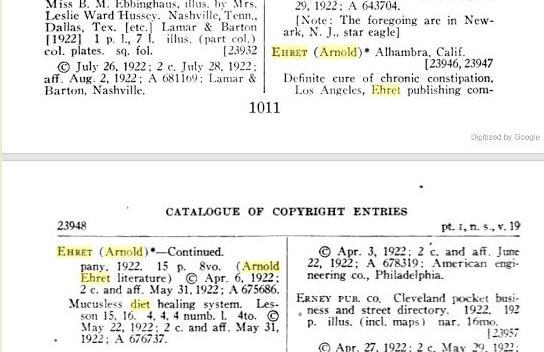
Figure 2. From the U.S. Catalogue of Copyright Entries, 1922 showing parts of the Mucusless Diet copyrighted in 1922.
Since 1994, the most widely read English language edition of the Mucusless Diet has been the 1994 edition. However, there are a number of significant changes that were made by the editor when compared to the 1924 editions. I highlight some of these changes below.
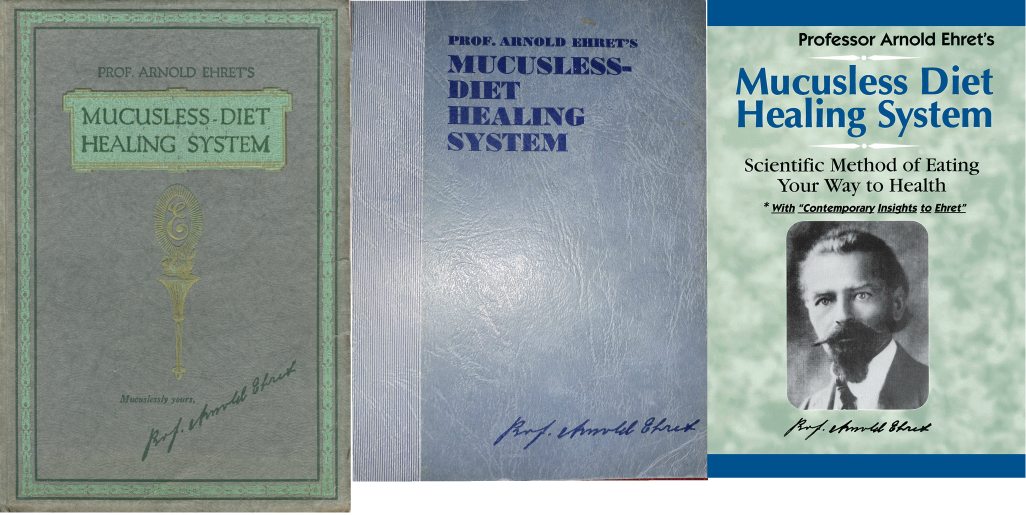
Figure 3. Mucusless Diet Book Covers from Left to Right: 1924 4th Ed., 1924 6th Ed., 1994 22nd Ed.
The Use of Mayonnaise and Cottage Cheese on the Mucusless Diet
I understand that a group of Mucusless Diet practitioners from the Spanish-speaking community use the egg-based mayonnaise mentioned in the original Mucusless Diet. Although I do not promote the general use of egg-based mayonnaise, I have never ridiculed or attacked people who use it.
Given that we must consider each person’s situation individually, as highly recommended by Ehret, I have suggested egg-based mayonnaise or cottage cheese to a few of my clients when I thought it was necessary. However, these recommendations often were based on the extent of their addiction to worse pus-forming foods. In those cases, it was better to recommend these pus-forming options then to have them continue to relapse on, or continue to crave, meat and dairy products.
However, the length of time those items needed to be used was fairly short, especially when the clients followed Ehret’s advice to do enemas, and in all cases the clients quit eating these items on their own without any encouragement from me.
Although I did not need to use egg-based mayonnaise for my own transition, I did use cottage cheese, particularly cottage cheese, applesauce, and dried fruit as mentioned in Lesson XVII (1994, 22nd Ed.). Early on in my transition, I did use some vegan, soymilk-based mayonnaise, but not often and only for a short period of time.
Ultimately, because I was following Ehret’s system as best as I could, which included short-term fasting periods (1-3 days at a time), the use of internal baths (enemas), and “progressively changing menus” toward cleaner mucus-free options that included raw and cooked fruits and vegetables, within several months of transitioning I no longer craved cottage cheese or any other animal products.
If I did eat cottage cheese, it made me feel very ill. As I cleaned out my colon from years of impacted fecal matter and poisons, I naturally became more intolerant to dairy and other animal products and lost the desire for them. I never tried to force myself to eat a plant-based Mucusless or Mucus-lean Diet, but after much of the residues from pus-forming foods were eliminated from my body, I no longer craved or could tolerate animal-based transitional products any longer.
I simply feel much better on a plant-based, Mucus-lean, and now a mostly mucus-free, diet. It has been like that for almost 15 years.
Questions Regarding Lesson XVII (Lesson XVIa in Older Editions): Vegetarian Recipes
As an editor of a new edition of the Mucusless Diet, there were a number of problems that I needed to address in the Vegetarian recipes lesson. Firstly, Prof. Arnold Ehret DID NOT write much of this lesson. In an original editor’s note, Fred Hirsch explains:
“Note: Professor Ehret frequently refers to having purposely omitted recipes, in spite of repeated requests, and gave as his reason: ‘In Nature, such as exists in the animal kingdom, there are absolutely no mixtures at all. The ideal and most natural method of eating is the mono-diet. One kind of fresh fruit, when in season, should constitute a meal, and you will find yourself better nourished. This condition, of course, cannot take place until you have thoroughly cleansed your body of toxemic poisons, mucus, or call it foreign substances.’
We feel sure that Professor Ehret would have approved and granted permission to include a few mucus-lean recipes, particularly of salads, in this edition of his Mucusless Diet Healing System, after being convinced as we have been that the public demand requires substitutes from the present-day acknowledged method of food preparation if they are to successfully take up the Ehret method. And so, with this thought in view, and with the hopes of converting many more to the Ehret System, we present a few tested recipes; successfully used at Health Cafeterias, where the tasty, delicious cooked combinations prove an agreeable surprise to the skeptic. Numerous other equally tasty menus can be arranged by simply changing either the cooked vegetable or combination of raw vegetables. The ideal diet for humans is the mono-diet and mixtures are prone to lead to gluttony, so that this should be remembered when arranging the meal.” (Fred S. Hirsch, Editor’s note in the 1924 edition, See Figure 4).”
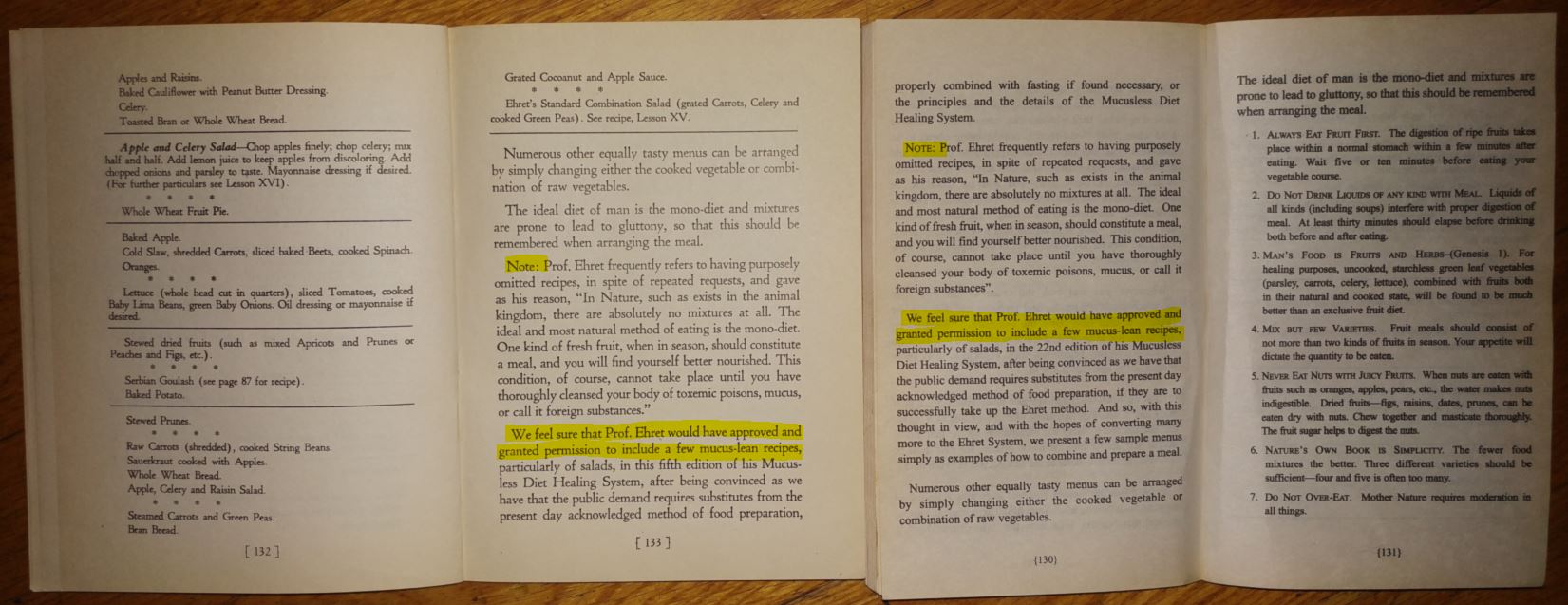
Figure 4. Left to Right, Fred Hirsch’s Publisher’s Note Highlighted: 1924 6th Ed.; 1994 22nd Ed.
It is not sure exactly who the editor is speaking of when he says, “we feel sure,” but it may be other colleagues and students of Ehret. In the original 1924 4th edition, there is a note from Ehret’s Mucusless Diet “Class of 1922,” and the original intention of the book was to act as a guide for students in his course. Ultimately Fred Hirsch made the final decisions as editor.
Thus, it must be understood that Hirsch, who was the first editor of the Mucusless Diet, admittedly made additions and changes to the book after Ehret’s death. Many of these additions and changes occur in the vegetarian recipe lesson. Furthermore, Hirsch continued to update and make significant changes to the lesson in subsequent editions. The 1994 edition eliminated a number of recipes found in the 1924 editions of the Mucusless Diet. It also divided up the second part of the Transition Diet lesson (XVIa) into two lessons. Thus, the Vegetarian Recipes lesson is now commonly known as Lesson XVII.

Figure 5. Left to Right: Vegetarian Recipes Lesson XVI—Part II in Mucusless Diet 1924, 6th Ed.; Vegetarian Recipes Lesson XVII in Mucusless Diet 1994, 22nd Ed.
The names of some recipes found in the 1924 edition which were removed by the 1994 edition include “Mock Ham Loaf,” Protose Cutlets,” “Protose Hash,” “Protose Stew,” and “Vegetable Oysters (Stew).” Items like protose (meat substitute made out of wheat gluten) that were heavily used in the 1924 4th edition were eliminated by the 1953 13th edition, and subsequently the 1994 22nd edition. Furthermore, the 1994 edition includes recipes not found in the 1924 edition, including “Lima Beans and Cabbage Casserole (See Figure 6).” Perhaps in the future, I’ll write a more in-depth article that compares the changes made to this lesson over the decades by editor Fred S. Hirsch.
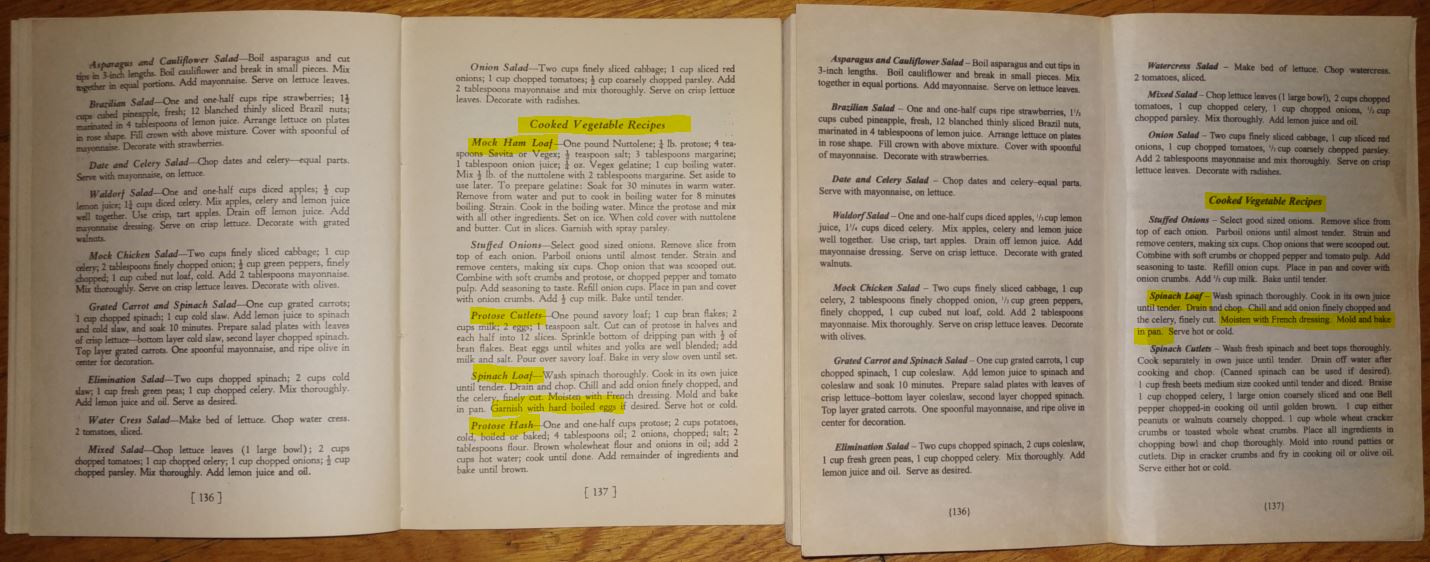
Figure 6. Left to Right: Comparing the “Cooked Vegetable Recipes” section added and edited by Fred Hirsch, 1924, 6th Ed., 1994, 22nd Ed.
Given that the original editor the Mucusless Diet made substantial changes to this lesson over the years, I found it reasonable to continue that tradition with some updates to this lesson.
A member of a Spanish-language Ehret Facebook support group asked why the Annotated Mucusless Diet was not a straight translation of the original, and implied that I was twisting or manipulating Ehret’s words. This was not my intention, as I clearly indicate that I took an editorial liberty and excluded certain egg-based items in the Annotated edition. It was not an attempt to trick the reader, as I made it clear in the introduction as well as in this lesson’s footnotes that I made these specific changes.
My exclusion of certain egg-based items in the Annotated edition of the Mucusless Diet was inspired by several factors, one of them being community feedback. Another, being data from numerous Mucusless Diet practitioners who either did not use these items to transition, or report negative symptoms associated with their usage. The English-language Mucusless Diet community of which I joined 15 years ago is a fairly progressive group with a number of high-level, long term practitioners in superior health.
Practitioners such as Sister Tekoa and Brother Air (aka Willie Smart) have far more energy than people half their age and have been practicing plant-based levels of the Mucusless Diet for over 30 or 40 years. They did not use egg-based mayonnaise or cottage cheese to transition, nor did they recommend it to the dozens of people that they personally helped learn to practice the Mucusless Diet over the years.
There are a number of others who fit in this category. The clinical data and experiences of many modern-day practitioners suggest that egg-based mayonnaise and cottage cheese can do more harm than good, particularly if they are used for long periods of time.
Overall, the annotated edition reflects the practice, interpretation, and values of the Mucusless Diet community of which I became a member. Philosophically, I subscribe to the post-modernist notion that it is impossible for any author to create a totally objective piece of work. This framework is suspicious of any writer that fails to consider the larger socio-cultural context of their own or other’s work.
Within this scholarly tradition, writers endeavor to share and acknowledge their biases subjectively instead of presenting their research as detached and objective.
In the introduction to the annotated edition book and throughout in the footnotes, I tried to be as transparent as possible about editorial changes that were made. To reiterate, the annotated edition is designed to be an additional studying tool and is NOT INTENDED AS A REPLACEMENT for one of the original Mucusless Diet Healing System editions.
Secondly, given the fact that the lesson in question was significantly changed by the editor and publisher over the years, it is not unreasonable for a present-day editor to make similar changes, as long as the reader is informed.
During the creation of the annotated edition, I most heavily referenced both the 1924 and 1994 editions. In this lesson, I synthesize recipes from both 1924 and 1994 editions.
Given that the annotated Mucusless Diet is not explicitly meant for an academic audience, I did not feel the need to notate every particular editorial change. I take a broader approach, but make it clear to the reader that certain changes were made in this lesson in case they want to consult other editions. Here is the relevant footnote from this lesson where I inform the reader of the few changes I made:
Excerpt from the Annotated Mucusless Diet footnote section for Lesson XVII:
“Similar to Lesson XIV with the problematic Ragnar Berg table, this chapter on vegetarian menus needed minor upgrades for the twenty-first century reader. First, it should be noted that much of this chapter was added by the book’s editor Fred Hirsch, and not Arnold Ehret. Also, the menus in this chapter have considerably changed over the years. Items like protose (meat substitute made out of wheat gluten) that were heavily used in the 1924 sixth edition were eliminated by the 1953 13th and 1994 22nd edition.
My goal is not to rewrite this chapter, but to improve on the menus presented. There are about five or six that I eliminated completely, as I find the ingredients or mixtures to be unsalvageable. Essentially, I eliminate all use of eggs (such as mayonnaise with egg, etc.) and most use of rice and milks. I also changed all use of white potatoes, which Ehret strongly advises against eating, to sweet potatoes which are almost mucusless when fully baked. And I got rid of most vegetaric meat substitutes and nut loaves, but left a couple of them for people who feel they need to use them in the beginning. Although some vegans may protest, I keep some of the cottage cheese combinations intact. Many people do not need to use such a menu, yet they can be very helpful in certain cases. It is not something that more advanced practitioners need to explore. Further, if you are transitioning properly, you will not be able to tolerate any kind of dairy for very long.
What I do not want to do is deprive someone of a transitional item that they may need or be able to use to overcome a challenging dietetic obstacle. Since transitional thinking is not finite, but ever-changing, the practitioner should know that such items cannot be eaten for extended periods. Those that only want to use the diet for a short period to heal will now have some things to fall back on that are better than a standard pus- and mucus-forming diet. Overall, for every bad item, there must be an item of lesser evil that is only a step away. Eating the baked banana, apple sauce, and chopped dates meal helped me get off of cottage cheese almost immediately. Wheat/grain toast, wheat spaghetti, etc., were all areas that I visited for varying periods of time to overcome hurdles. (For more details about how I used these foods in my own transition, check out my book Spira Speaks: Dialogs and Essays on the Mucusless Diet Healing System). (Prof. Spira, Annotated Mucusless Diet, 2014).”
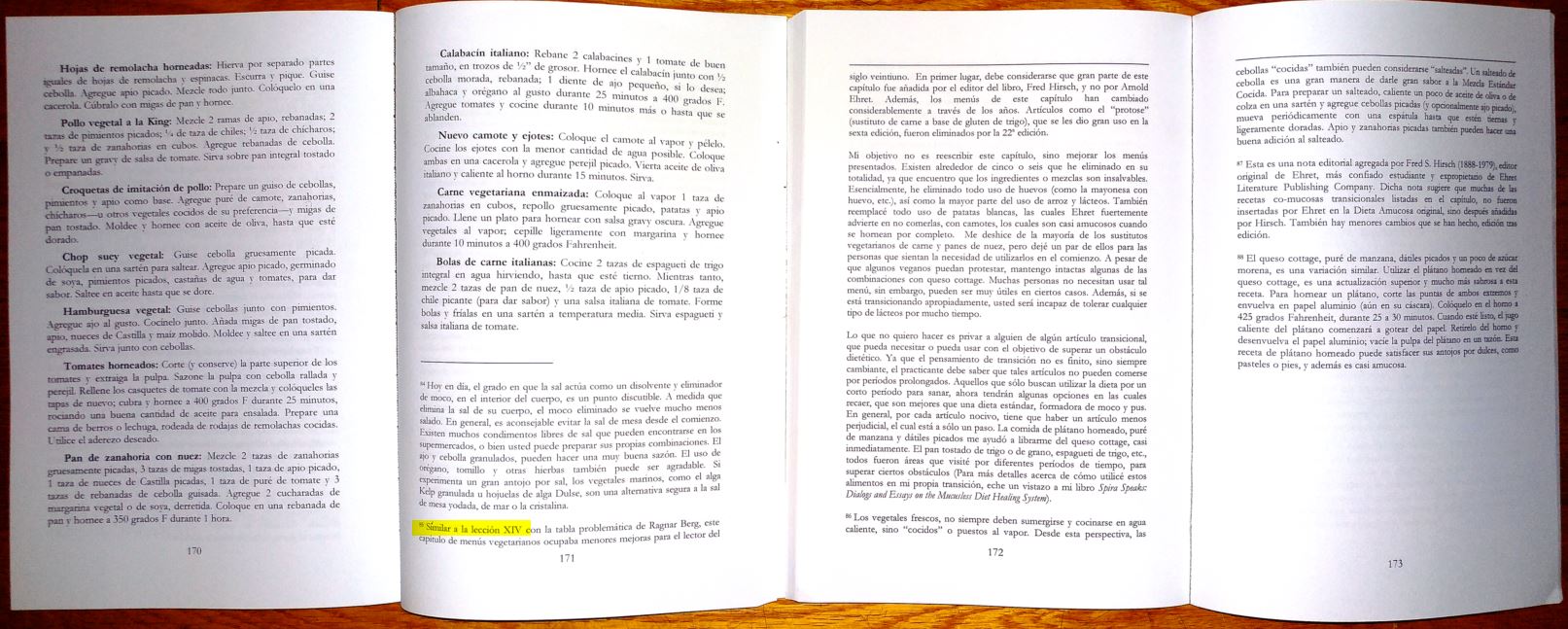
Figure 7. Showing the footnote referenced above from Lesson XVII in the Annotated, Revised, and Edited Mucusless Diet Healing System.
Perhaps my avoidance of egg-based products when not necessary comes most directly from Prof. Arnold Ehret. Ehret says:
“Meats
All are in a decomposing state, producing cadaver poisons, uric acid in the body and mucus; fats are the worst, even butter is unusable for the human body. No animals eat fat.Eggs
Eggs are even worse than meats. This is because not only do eggs have too high protein qualities, but they also contain a gluey property much worse than meat and are therefore very constipating, quite more so than meat. Hard-boiled eggs are less harmful, because the gluey qualities are destroyed. The white of eggs makes perfect glue. (Arnold Ehret, Mucusless Diet Healing System, all editions).”
He also mentions, “A consumptive patient starts with such terrible elimination after a short fast that it must be plain to all how ignorant and how impossible it is to try to cure him with “good nourishing foods” such as eggs and milk (Ehret, Mucusless Diet, all editions).”
It is clear to me that Ehret was not a fan of using eggs unless necessary, and certainly not for an extended period of time.
I realize that some practitioners looked at the point about hard-boiled eggs as a suggestion to use them during the transition. However, Arnold Ehret NEVER RECOMMENDED USING HARD-BOILED EGGS—as far as I have been able to find. In the aforementioned statement, he attempts to make a point that the items are less harmful because some of the gluey properties are cooked out, but he never says that they should actually be eaten or used during one’s transition. In the 1924 6th edition of the Mucusless Diet, Fred Hirsch includes “hard boiled eggs” in the recipe for “Spinach Loaf.” Hirsch writes:
“Spinach Loaf-Wash spinach thoroughly. Cook in its own juice until tender. Drain and chop. Chill and add onion finely chopped, and the celery, finely cut. Moisten with French dressing. Mold and bake in pan. Garnish with hard boiled eggs if desired. Serve hot or cold (Fred Hirsch, editor’s addition, Mucusless Diet, 1924 6th edition, see figure 6).”
However, presumably Hirsch removed all added instances of using “hard boiled eggs” by 1953 and subsequent editions. The 1994 edition for the same recipe reads:
“Spinach Loaf-Wash spinach thoroughly. Cook in its own juice until tender. Drain and chop. Chill and add onion finely chopped, and the celery, finely cut. Moisten with French dressing. Mold and bake in pan. Serve hot or cold. (Presumably Fred Hirsch, editor, Mucusless Diet, 1994 22nd edition, see figure 6).”
Why did Fred Hirsch, the person who added “hard boiled eggs” to a recipe in the Vegetarian recipe lesson in 1924, take the item out of later editions? In the 1994 edition, I can find no instance of Hirsch or Ehret suggesting that hard boiled eggs be used.
Egg-based Mayonnaise?
Lesson XVI is the first place where Ehret mentions mayonnaise, although he does not say that it must be egg-based mayonnaise at this point. Under the subheading “Dressings” he says:
“This is really a question of personal taste. A good salad or olive oil with lemon juice to taste is simple and good. A spoonful of peanut butter or nut butter dissolved in water and a little lemon juice added is another simple recipe. Add finely sliced onions (green) if desired. Homemade mayonnaise, using lemon instead of vinegar, is not especially harmful during the transition diet and can be used if you enjoy it. Tomatoes cooked into a sauce, or a good canned tomato soup mixed with the dressing may help you enjoy the ‘transition diet’ (Ehret, Mucusless Diet, all editions).”
Ehret says that mayonnaise can be “used if you enjoy it.” He certainly does not suggest that it is a mandatory condiment. In my own transition I used Ehret’s olive oil and lemon juice recipe, peanut butter/water/lemon juice recipe, tomato sauce recipe, as well as some other vinegar-free dressings. I never felt the need to use egg-based mayonnaise as a salad dressing. Since Ehret does not require or emphasize its importance, I did not feel pressure to use it. If I felt I needed to use it, I would have.
In the 1924 and 1994 editions, the majority of times when mayonnaise is suggested in recipes, they are the ones added by the editor Fred Hirsch and not Arnold Ehret. From my count, the word “mayonnaise” shows up 22 times in the 1924 edition, and 19 times in the 1994 edition. In the 1924 edition, at least 17 of the times mayonnaise is suggested, it is done by Fred Hirsch in his added vegetarian menu section (see Figure 8). The several instances of mayonnaise mentioned in recipes before Fred Hirsch’s note, usually indicate that it is optional. For instance “dressing or mayonnaise if desired.”
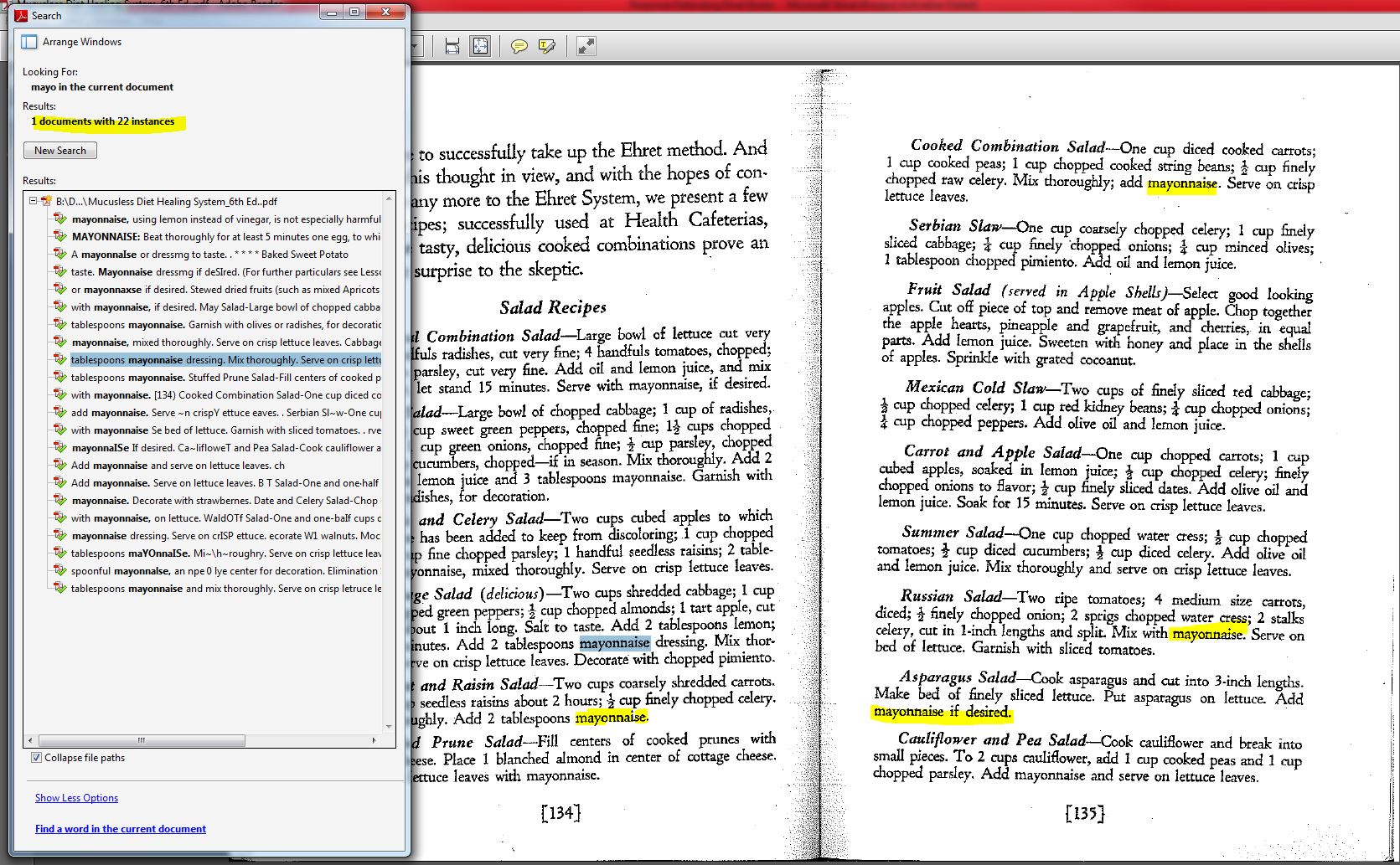
Figure 8. Search for the word “mayo” in the 1924 6th edition that shows it’s primary usage in the Mucusless Diet book in the addendum that the editor Fred Hirsch presumably added after Ehret’s death.
I took the editorial liberty and removed the mayonnaise recipe in lesson XVII. Like other items, this was changed by Fred Hirsch in later editions. The 1924 version reads
“MAYONNAISE: Beat thoroughly for at least 5 minutes one egg, to which add VERY SLOWLY a few drops at a time one pint of good salad oil (Wesson or Mazola), continue beating while adding oil Add lemon juice, salt and pepper to taste. If tomato flavor is desired you may add the juice of one tomato (Ehret or Hirsch, Mucusless Diet, 1924 6th Edition).”
The brands “Wesson or Mazola” were later deleted by Hirsch by the 1953 22nd edition. Given the amount of alterations made to this lesson, I have to question how much of the material before his editor’s note was altered or created by Hirsch as well. The fact remains that the note proves that a third party and not Ehret added many of the vegetarian recipes. Thus, as the editor of a new edition, I felt at liberty to make the minor updates I made, provided that I inform the reader.
I appreciate the concerns of those who were surprised to not see the mayonnaise recipe in Lesson XVII. I hope this explanation helps clarify why items in the Lesson XVII do not appear the same as the 1924 or 1994 editions. There were only two lessons that I felt demanded tough choices be made by the editor to make significant updates. These changes are made clear to the reader and are not outside of the purview of an annotated and critical edition of a written work.
The accuracy of current Spanish translations of the Mucusless Diet, whose purpose was to simply translate the English text with no alterations, is an interesting issue as well. I understand that a number of the existing Spanish translations of Ehret’s work have improperly translated material, such as the word “vegetable” being translated as “legume.” This is an issue that needs attention. I encourage Spanish-reading scholars of Ehret’s work to engage in a comprehensive comparative analysis of the English-language 1924 and 1994 editions with the most widely read Spanish editions. I think that it is important to uncover and discuss potentially problematic translation details that has effected how people interpret Ehret’s work.
My goal is not to criticize Fred Hirsch for his additions, or to persuade you to think twice about over-using your favorite egg-based mayonnaise, but to reread Ehret’s work more critically. I certainly do not suggest that you should ignore Hirsch’s additions, but put them into context. My advice when reading Ehret, Hirsch, or my own work, is to, as the long-term Ehretist Brother Air would say, “take what you need and leave the rest alone”—meaning examine all of the resources you can and then only use the information that is helpful for you in your personal situation. All I ask is that you keep an open mind and study deeply.
Fear of Fruit
I plan to dedicate a full post to this issue, but I would like to touch on it hear and direct you to some additional resources. I have heard that there is a growing fear of fruit within the Spanish Ehretist community. Fruit is an aggressive cleansing tool and must be used with care and precision during one’s transition. However, I find it concerning to suggest that most people avoid fruit for long periods of time, especially if they have no sugar metabolism issues.
Even Ehret points out that fruit is needed in such cases. He explains, “The next important laboratory test is that of sugar in the urine, Diabetes. The medical dictionary still calls it “mysterious?’ Instead of eating natural sweets, which go into the blood, and which can be used, the diabetic patient is fed eggs, meat, bacon, etc., and, in fact, actually starves to death thru lack of natural, sugar-containing and sugar-producing foods, which have been withheld (Ehret, Mucusless Diet, all editions).”
Ehret asserts that someone who does not get enough fruit is actually starving themselves of the natural sugar that can help cleanse and build a new vital blood composition.
Arnold Ehret explains,”
“The reason doctors and even naturopaths in general, as well as the layperson, do not believe in a FRUIT diet or MUCUSLESS diet, is simply this: Whoever experiments without experience with this diet of healing, whether sick or well, loses his faith immediately, as soon as they have a crisis, becomes what he or she believes to be “seriously ill;” that is to say, a day on which a great amount of dissolved waste, debris, mucus and other poisons are taken back into the circulation, a day of great elimination. This produces at the same time a strong, almost irresistible craving for wrong foods and, strange as it may seem, the patient most strongly craves for the wrong food which was once his favorite. This is explained by the fact that Nature is eliminating through the circulation the waste of these foods, and it is when they are in the circulation the craving and desire is naturally enough produced. (Ehret, Mucusless Diet, all editions).”
The illogical fear of fruit seems to stem from the stories of people who attempted to skip over any kind of transition and become a raw foodists or fruitarian. I do not promote all-fruit dieting, long-term fasting, or raw-foodism. I promote the Mucusless Diet Healing System. Ehret explains, “The mucusless diet consists of all kinds of raw and cooked fruits, starchless vegetables, and cooked or raw mostly green-leaf vegetables. The Mucusless Diet Healing System is a combination of individually advised, long or short fasts with progressively changing menus of non-Mucus-Forming Foods.” Ehret also emphasizes the use of enemas as an important tool of the system. Ehret explains,
“Air baths taken in the room, enemas, natural laxatives, and cool lemonade would save the lives of thousands of young men and women who are now daily permitted to die, the innocent victims of pneumonia or other acute diseases—due to the stubborn ignorance of doctors and so-called highly civilized people (Ehret, Mucusless Diet, all editions).”
In the “Internal Bath” section of Lesson XXV, he continues,
“During the transition period, even though you have regular bowel movements, it is advisable to wash out the lower colon. The sticky waste, slimy mucus, and various poisons which Nature is attempting to eject should be helped along as much as possible. A small-bulb infant syringe can be used after the regular bowel movement, but for a thorough cleansing, two to three quarts of water should be used (Ehret, Mucusless Diet, all editions).”
If enemas are totally avoided, then the immense poisons found in the colon will not efficiently leave the body and continue to produce cravings for pus- and mucus-forming foods. When someone tries to eat an all raw vegetarian or fruit diet with no transitional methodology and no enemas, they are putting themselves at serious risk and it is no surprise that they fail. However, because a few people did not know how to transition gradually according to Ehret’s methods, the rest of us need not be scared to eat fruit. The longest period of time that Ehret suggests going without any fruit is for a few days:
“Whenever you feel bad, the cause is that you have too much dissolved mucus and probably old drugs in the circulation; then slow down the elimination by not eating raw fruits or even cooked fruits at all and for a few days eat cooked or raw vegetables only. Vegetables work more mechanically and dissolve less (Ehret, Mucusless Diet, all editions).”
Also,
“If you find that you are losing weight too rapidly, the elimination should be slowed down by eating bread or potatoes after the vegetables. Should you feel an intense craving in the beginning for meat—a great desire returning which you cannot resist, then eat vegetables only on that day, and NO FRUITS (Ehret, Mucusless Diet, all editions).”
Notice that Ehret’s suggestion to omit fruit is conditional, and only for a short period of time in extreme situations. Ehret also recommends using baked or stewed fruits as less aggressive transitional items, which is a nuance of Ehret’s work that many people ignore. If one would follow Ehret’s Menus for the First 4 weeks, they would only eat cooked fruit for the first month. Then raw and cooked fruit is recommended from then on.
For more on what Ehret had to say about fruit diets and lack of proper transitioning, see the following articles:
“Art of the Transition: A Response to Dr. Stanley Bass and Others”
https://www.mucusfreelife.com/art-transition-diet-mucusless/
“Prof. Spira on Steve Jobs, Ashton Kutcher, Arnold Ehret, Radical Raw Fruit Diets, and the Transition”
https://www.mucusfreelife.com/jobs-kutcher-radical-fruit/
Mucus-free, the ORIGINAL Vegan Diet
I understand that there are some people in the Spanish-speaking community that are concerned with my use of the word “vegan” in relationship to a “mucus-free” or “mucusless” diet. In “Confusion in Dietetics: Lesson XII,” Ehret explains, “Raw fruits, and if desired, raw green-leafy vegetables, form the ideal food for humans. That is the mucusless diet (Ehret, Mucusless Diet, all editions).”
Thus, according to Ehret a mucus-free or mucusless diet is by definition a “plant-based” diet. Here, I use the word “vegan” as synonymous for “plant-based (Ehret, Mucusless Diet, all editions).” Ehret continues, “But the mucusless diet as a healing system uses raw, rough vegetables for their cleansing qualities; baked ones as food; and baked and stewed fruits AS A LESS AGGRESSIVE DISSOLVER of poisons and mucus to MODERATE THE ELIMINATION IN SEVERE CASES (Ehret, Mucusless Diet, all editions).” Even Ehret’s own definition of the healing system is plant-based in nature. However, “mucus-free” is not synonymous with the Mucusless Diet Healing System, which can include non-plant-based and processed foods. In this instance, the Mucusless Diet Healing System can be used as a tool to become “mucus-free” or “mucusless,” if one desires to do so. When someone is “mucus-free” for short or long periods of time, they are eating a plant-based, or “vegan” diet without being conscious of it.
Thus, to understand this statement, one must recognize the difference between a “mucusless diet” and the Mucusless Diet as a Healing System. My claim that Ehret put out the first widely circulated plant-based dietary book, is because Ehret’s primary goal is to get his patients onto a “mucusless” or mucus-free diet by using the transitional methods of his healing system.
Ehret says several times that, “the ideal menu for humans is the ‘mono-diet,’ consisting of one kind of fruit in season and I must again remind you that no animal in freedom is a “mixed eater” at one meal (Ehret, Mucusless Diet, all editions).” The “paradisiacal” life that Ehret repeatedly references as a goal for humans to strive for is a plant-based, mucus-free paradise. Thus, if one were to use the Healing System, which can include some non-plant-based items, to transition to a Mucus-free diet, they will have automatically transitioned to a plant-based, vegan diet.
To be precise, Ehret labels a transitional diet that still includes pus or mucus-forming foods to be a “mucus-lean diet.” Ehret explains, “As long as wrong foods (foods of civilization) are partly used, I call it a MUCUS-LEAN DIET. Transition means the slow change from disease-producing foods to disease-healing foods, which I call the MUCUSLESS DIET (Ehret, Mucusless Diet, all editions).”
As mentioned above, I personally used cottage cheese during my transition, although it was only for a few months—not for a few years. How long should we use certain transitional items in our diet? Ehret does not provide a clear cut answer. He explains, “The speed of elimination depends upon quantities and qualities of food and can therefore be controlled and regulated according to the condition of the patient (Ehret, Mucusless Diet, all editions).”
Thus, the speed of one’s transition should be in accord with their physiological condition. Yet, Ehret also says, “For the ordinary person, it will require from 1 to 3 years of systematically continued fasting and natural, cleansing diet before the body is actually cleansed of ‘foreign matters.’ You may then see how the body is constantly eliminating waste through the entire outside surface of the body, from every pore of the skin, the urinal canal, and the colon, from the eyes and ears, and from the nose and throat (Ehret, Mucusless Diet, all editions).” In response to the aforementioned, in the footnote section I write,
“Many beginners of the mucusless diet wonder how long it will take to totally cleanse the body. Ehret says, ‘For the ordinary person, it will require from 1 to 3 years of systematically continued fasting and natural, cleansing diet before the body is actually cleansed of ‘foreign matters’.’ However, this statement is often misinterpreted to mean that it will only take 1 to 3 years to reach the highest levels of a mucusless lifestyle. In actuality, transitioning for 1 to 3 years is only the beginning of the process. If you have followed the program, within the first several years you should have eliminated the pounds of excess fecal matter from your bowels and started to deeply cleanse on the cellular level. But, based on the experiences of many long-term practitioners of the mucusless diet, it takes decades to totally cleanse the body and reach the highest levels. Yet, this should not deter you, as I suggest that you not be concerned with “how long” the diet will take. Time is relative to each person and we did not produce our physical ailments overnight. We must make compensation for the past, and it will take time. The key is to keep transitioning! (Prof. Spira, Annotated Muculsess Diet, 2014).”
Many more discussions on this topic must happen in the future. Since Ehret gives no concrete length of time in which one needs to achieve various levels of cleanliness, we need to share our experiences with one another and discuss these questions together. For further reading on the question of the plant-based nature of the Mucusless Diet, as well as a bit of history about Fred Hirsch and Ehret, check out this article: https://www.mucusfreelife.com/vegan-diet/ .
In Sum
In future posts, I will address questions about differing interpretations of Ehret’s fasting philosophies, questions about the changes I made to the Ragnar Berg lessons in the annotated edition, and how long the “transition diet” should or could take, and differing philosophies regarding the ultimate goal of the Healing System.
If you are interested in taking a look at the Annotated, Revised, and Edited, Mucusless Diet Healing System for yourself, you can get PDF or paperback copy here: https://www.mucusfreelife.com/product/annotated-mucusless-diet/ . The book should also be available on your local Amazon.com site in Kindle or paperback formats: http://amzn.to/2tseqQC.
Peace, Love, and Breath!
Prof. Spira, PhD
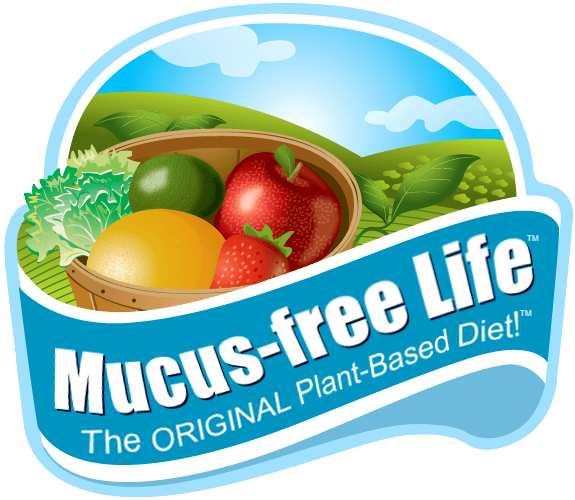
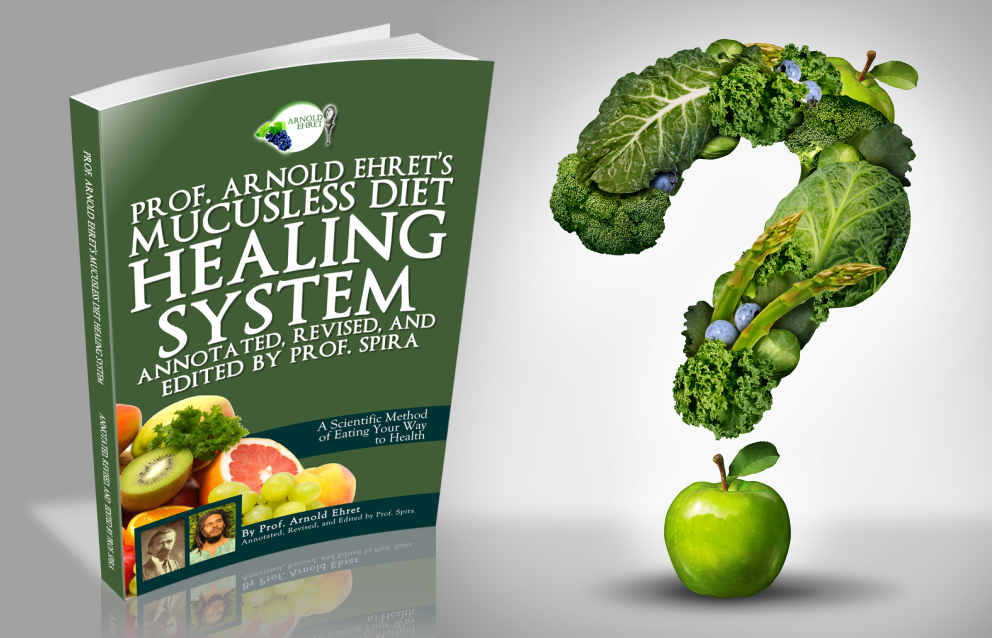

Pingback: Baked Banana Recipe & Dealing with Food Relapse on the Mucusless Diet
Pingback: Conversation -Prof. Arnold Ehret vs. Dr. Christopher Mucusless Diet